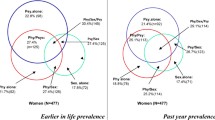Abstract
Our aim was to describe the prevalence and associated factors of intimate partner violence in postcommunist countries of South East Europe (SEE). Review of recent reports regarding intimate partner violence in SEE countries as documented in the official Web sites of the World Health Organization (WHO), the United Nations Children’s Fund (UNICEF), Minnesota Advocates for Human Rights, Centers for Disease Control, and Medline. In Belgrade, Serbia and Montenegro, the prevalence of physical violence against women has been reported as 69.8%. In a reproductive health survey conducted in 1997 in Moldova, 22% of the women interviewed reported they had been abused by a partner or former partner at some time in their lives. More than 31% of female university students in Macedonia have reported that they had been victims of physical or psychological violence. Data from Albania indicate that spousal physical violence is one of the highest reported internationally. In Tirana, the Albanian capital city, the prevalence of past-year physical intimate partner violence was reported by 37% of women interviewed. The most empowered Albanian women were most likely to experience physical abuse and the least powerful men and those of rural origin were most likely to perpetrate spousal violence. Notwithstanding the lack of well-documented data and the questionability of extent to which the reported results are comparable among different SEE countries, the evidence suggests that intimate partner violence is an important public health problem in transitional countries of SEE. Information on intimate partner abuse can provide valuable clues to primary care and community care practitioners about the health status of female populations.
Similar content being viewed by others
References
Baban A (2003). Domestic violence against women. UNICEF. Available from: http://www.unicef.org/albania/domviol_eng.pdf (accessed 20 Apr 2005)
Bourgois P (1996) In search of respect: selling crack in El Barrio. Cambridge University Press, Cambridge
Burazeri G, Roshi E, Jewkes R, Jordan S, Bjegovic V, Laaser U (2005) Factors associated with spousal physical violence in Albania. Br Med J 331:197–201
Campbell JC (2002) Health consequences of intimate partner violence. Lancet 359:1331–1336
Ellsberg MC, Pena R, Herrera A, Liljestrand J, Winkvist A (1999) Wife abuse among women of childbearing age in Nicaragua. Am J Public Health 89:241–244
Ignjatovic T et al (eds) (2003) I don’t want to leave in fear any more - Three-year report of Autonomous Women Centre on working with women who are victims of violence. Autonomous Women Centre, Belgrade. Available from: http://www.womenngo.org.yu (accessed 17 Jul 2005)
Institute of Statistics of Albania (2002). The population of Albania in 2001. Tirana: INSTAT
Jewkes R (2002) Intimate partner violence: causes and prevention. Lancet 359:1423–1429
Jewkes R, Penn-Kekana L, Levin J (2002). Risk factors for domestic violence: findings from a South African cross-sectional study. Soc Sci Med 55:1603–1617
Kantor GK, Jasinski JL, Aldarondo E (1994). Socio-cultural status and incidence of marital violence in Hispanic families. Violence Vict 9:207–222, (Special issue: Violence against women of colour.)
Martin SL, Tsui AO, Maitra K, Marinshaw R (1999) Domestic violence in northern India. Am J Epidemiol 150:417–426
Minnesota Advocates for Human Rights (1998). Domestic violence in Macedonia. p. 11. Available from: http://www.mnadvocates.org/sites/608a3887-dd53-4796-8904-997a0131ca54/uploads/macedonia.PDF (accessed 20 Apr 2005)
Minnesota Advocates for Human Rights (2000). Domestic violence in Moldova. p. 15. Available from: http://www.mnadvocates.org/sites/608a3887-dd53-4796-8904-997a0131ca54/uploads/moldova.pdf(accessed 20 Apr 2005)
Moore H (1994) A passion for difference: essays in anthropology and gender. Polity Press, London
Nuri B, Tragakes E (eds) (2002) Health care systems in transition: Albania. Copenhagen: European observatory on health care systems. Available from: http://www.who.dk/document/E80089.pdf (accessed 11 Jul 2005)
Rechel B, McKee M (2003) Healing the crisis: a prescription for public health action in South Eastern Europe. Open Society Institute Press, New York
Strauss MA, Gelles RJ, Steinmetz SK (1980) Behind closed doors: violence in the American family. Anchor, New York
U.S. Department of Health and Human Services (1997). Reproductive Health Survey, Moldova. Centers for Disease Control and Prevention
Watts C, Zimmerman C (2002) Violence against women: global scope and magnitude. Lancet 359:1232–1237
Wood K, Jewkes R (2001) “Dangerous” love: reflections on violence among Xhosa township youth. In: Morrell R (ed) Changing men in Southern Africa. University of Natal Press, Pietermaritzburg
World Health Organization (2002) World report on violence and health. Geneva, Switzerland. Available from: http://www.who.int/violence_injury_prevention/violence/world_report/en/full_en.pdf (accessed 27 Dec 2005)
Disclosure statement
The study carried out in Tirana in July–October 2003 was supported by the Institute of Health Education and Human Welfare, Lublin, Poland (Burazeri G et al. 2005. Factors associated with spousal physical violence in Albania. BMJ 331:197–201).
Author information
Authors and Affiliations
Corresponding author
Rights and permissions
About this article
Cite this article
Burazeri, G., Roshi, E. & Tavanxhi, N. Intimate partner violence in the Balkans: the example of Albania. J Public Health 14, 233–236 (2006). https://doi.org/10.1007/s10389-006-0046-4
Received:
Accepted:
Published:
Issue Date:
DOI: https://doi.org/10.1007/s10389-006-0046-4



